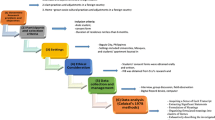Abstract
The aim of this study was to examine how Muslim Arab–Israeli teachers conceptualize the Israeli–Arab conflict with their students. The findings show that Arab schools are in a constant state of tension between opposing poles of identity and belonging. The teachers emphasize their students’ alienation from the Israeli establishment and their lack of identification with the Jewish state, while expressing deep identification with the Palestinian people. They are able to cope with this split by seeking contents and coping mechanisms of a universal nature that are not in dispute, and which enable students to repress the dissonance in which they live.
Similar content being viewed by others
References
Abu-Asba, H. (2007). Arab education in Israel: Dilemmas of a national minority. Jerusalem: Floersheimer Institute for Policy Studies.
Abu-Asba, H., Jayusi, W., & Sabar-Ben Yehoshua, N. (2011). The identity of Palestinian youngsters who are Israeli citizens: The extent of their identification with the state and with Jewish culture, and the implications for the education system. Dapim: Journal for Studies and Research in Education, 52, 11–45 [Hebrew].
Al-Haj, M. (1998). Education for multiculturalism in Israel in light of the peace process. In M. Mautner, A. Sagi & R. Shamir (Eds.), Multiculturalism in a democratic and Jewish state, (pp. 703–714). Tel Aviv: Ramot. [Hebrew].
Aloni, N. (2005). Peace education and democracy. In: N. Aloni (Ed.), On becoming human: An anthology of philosophy of education, (pp. 384–396) Tel-Aviv: Mofet and Hakkibutz Hameuchad. [Hebrew].
Bar-Tal, D., & Teichman, Y. (2005). Stereotypes and prejudice in conflict: Representations of Arabs in Israeli Jewish society. New York: Cambridge University Press.
Bhabha, H. K. (1994). The location of culture. London: Routledge.
Bush, K. D., & Saltarelli, D. (2000). The two faces of education in ethnic conflict towards a peacebuilding education for children. Florence: Innocenti Research Centre, United Nations Children’s Fund.
Dajani, M. S. (2006). Big dream/small hope: A peace vision. In Y. Iram, H. Wahrman, & Z. Gross (Eds.), Educating toward a culture of peace (pp. 39–56). Greenwich, CT: Information Age Publishing.
Davies, L. (2003). Education and conflict: Complexity and chaos. London: Routledge Falmer.
Davies, L. (2005). Teaching about war in “stable” and “conflictual” societies. Paper presented at the International Conference on Citizenship Education in Conflicted Societies, Jerusalem and Haifa, 29 May–1 June 2005.
Gross, Z. (2003). State-religious education in Israel: Between tradition and modernity. Prospects, 33(2), 149–164.
Horowitz, D., & Lissak, M. (1989). Trouble in utopia: The overburdened polity of Israel. Chicago: University of Chicago Press.
Jamal, A. (2007). Education toward peace and multiculturalism in a multi-conflict society. Interdisciplinary Thought in Humanistic Education, 2, 11–16 [Hebrew].
Kimmerling, B. (2004). Immigrants, settlers, natives: The Israeli state and society between culture, pluralism and cultural Wars. Tel-Aviv: Am Oved [Hebrew].
Kolakowski, L. (1990). Looking for the barbarians: The illusions of cultural universalism. In L. Kolakowski (Ed.), Modernity on endless trial (pp. 14–31). Chicago: University of Chicago Press.
Kukathas, C. (1997). Cultural toleration. In W. Kymlicka & I. Shapiro (Eds.), Nomos 39: Ethnicity and group rights (pp. 69–104). London: New York University Press.
Kymlicka, W. (1989). Liberal individualism and liberal neutrality. Ethics, 99, 883–905.
Kymlicka, W. (1995). Multicultural citizenship. Oxford: Clarendon.
Lamm, Z. (2002). In the whirlpool of ideologies: Education in the twentieth Century. Jerusalem: Magnes. [Hebrew].
Levinas, E. (1969). Totality and infinity: An essay on exteriority (trans: Lingis, A.). Pittsburgh, PA: Duquesne University Press.
Lewis, B. (1998). The multiple identities of the Middle East. New York: Schocken Books.
Liebman, C. S. (1982). Neo-traditional development among Orthodox Jews in Israel. Megamot, 27, 231–250 [Hebrew].
Salomon, G. (2002). The nature of peace education: Not all programs are created equal. In G. Salomon & B. Nevo (Eds.), Peace Education: The concept, principles and practices around the world (pp. 3–14). Mahwah, NJ: Lawrence Erlbaum Associates.
Tamir, Y. (1995). Two concepts of multiculturalism. Journal of Philosophy of Education, 29(2), 161–172.
Acknowledgment
This research was sponsored by the Tami Steinmetz Center for Peace Research, Tel Aviv University, Israel.
Author information
Authors and Affiliations
Corresponding author
Rights and permissions
About this article
Cite this article
Gross, Z., Gamal, E. How Muslim Arab–Israeli Teachers Conceptualize the Israeli–Arab Conflict in Class. Stud Philos Educ 33, 267–281 (2014). https://doi.org/10.1007/s11217-013-9392-1
Published:
Issue Date:
DOI: https://doi.org/10.1007/s11217-013-9392-1




